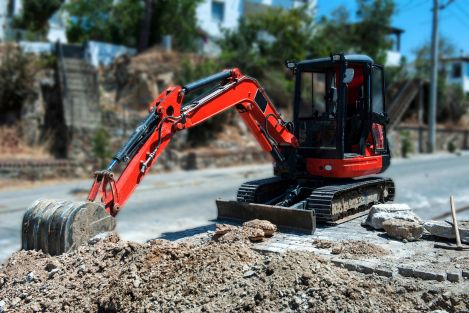
Written by Kayla Jane Barrie Updated on Mar 03, 2025 5 mins read

Did you know you are responsible for the underground service lines on your property? If something goes wrong and they need to be replaced, you might have to pay out of pocket if your policy does not include service line coverage.
Service line coverage is often one of the overlooked areas of home insurance. This additional protection can protect you from losses due to damage to service lines. In this blog post, we'll delve into the details of service line coverage in Ontario, exploring what it is, why it matters, and how it can provide homeowners with peace of mind.
A service line refers to the underground or above-ground pipes, conduits, or cables that connect a property to the municipal or utility service infrastructure. These lines deliver essential services such as water, sewer, drainage, gas, electricity, or internet connectivity to residential and commercial buildings.
Here are some common types of service lines :
Understanding the types and conditions of the service lines on your property is important for ensuring proper maintenance, identifying potential issues, and obtaining appropriate coverage to protect against unexpected damages or repairs.
Service line coverage is an element of an insurance policy that protects homeowners from costly repairs or damages associated with service lines that are connected to their properties. Unfortunately, these lines are susceptible to damage due to various factors, including tree root invasion, ground shifts, aging, and severe weather. The repairs or replacement of service lines can be a significant financial burden, often costing thousands of dollars.
In Ontario, homeowners are typically responsible for maintaining and repairing their service lines from the point where they connect to the municipal service infrastructure to their property. This is where ensuring you have an adequate amount of service line coverage on your Ontario home insurance, becomes crucial, as it can help offset the financial impact of unexpected repairs or replacements.
Service line coverage typically protects against wear and tear, deterioration, mechanical breakdown, or accidental damage. It can cover costs associated with excavation, repair, replacement, and even living expenses during the repair process.
It is important to note that service line coverage may vary among insurance providers. Some policies might have specific exclusions or limitations, such as only covering damage caused by sudden events rather than gradual deterioration and various deductibles. It's crucial to review your policy carefully and consult with your provider to understand the specifics of your coverage.
The cost of service line coverage can vary depending on several factors, including the insurance provider, the specific coverage limits and deductibles chosen, the property's location, and the service lines' age and condition. On average, the cost of adding service line coverage to a homeowners' insurance policy can range from $30 to $100 per year.
While the additional premium for service line coverage may seem like an extra expense, it can provide significant financial protection and save homeowners from incurring substantial out-of-pocket costs in the event of service line damage.
Service line damage can occur due to various causes, and the specific causes of loss can depend on factors such as the type of service line (water, sewer, power, etc.), the location, and the surrounding environmental conditions. Here are some common causes of loss from service line damage:
Reviewing the policy language and discussing it with your insurance provider can clarify the specific causes of loss covered by your service line coverage.

Depending on your policy and the cause of the service line claim, you may be covered in the following areas:
Homeowners in Ontario can typically add service line coverage as an endorsement to their policy. Contact your insurer to discuss the options available and determine the additional cost of adding this coverage.
Yes, service line coverage is important. It can help protect you from costly repairs, problems from aging infrastructure, and unforeseen events and help ease the claims process. While service line coverage may involve an additional cost, it can save homeowners significant money in the long run. Comparing home insurance from multiple insurers can help you find the best coverage at a competitive price.
Yes, insurance coverage for service lines is available and can be obtained as an add-on to a policy. Service line coverage protects homeowners from the costs of repairing or replacing service lines that connect their property to the municipal infrastructure. Remember that the coverage has specific inclusions, exclusions, and limitations.
Sewer line insurance is similar to service line coverage. If you have this additional protection on your policy, you might be covered for any fees associated with locating and repairing damaged lines on your property.
Service line coverage protects property owners against unexpected repairs and replacements of their water, sewer, drainage, and power lines.
By understanding the importance of service line coverage, reviewing your policy, and taking proactive steps to maintain your service lines, you can safeguard your home and your finances and enjoy peace of mind knowing that you are prepared for any unforeseen circumstances.
| Categories | Home |
|---|---|
| Tags | Homeowners ClaimsProtect Your HomeHome Coverage |
Read our insurance blog to get helpful tips, information and news.
Has your car been totalled in an accident? Is your car a write off? Learn about vehicle write offs for a total loss insurance claim.
Get the facts on Toronto's auto theft problem. We break down the data, reveal the most-stolen vehicles (including the Honda CR-V and Lexus RX 350), and show which neighbourhoods are most affected.
Dive into the world of auto theft with our blog on the most stolen cars in Canada. See the most stolen cars across Canada, including provincial lists for Ontario and Quebec, and learn how high-risk models can affect your car insurance premiums.
Drive safe this winter! Check out these tips for driving in snowy and icy conditions in Ontario. Get other helpful info and FAQs on winter driving.